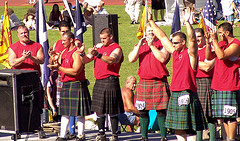2. Paco has made a new friend
Paco has decided to send a few postcards to his family and friends. He got up early this morning and he went to Princes Street, which is always full of shops and people. He has bought a few postcards and he has gone to a nice café to sit down and write.
After half an hour, he has finished his drink and now wants to look for a Post Office. He has seen a young man of about his age sitting at the table next to him and reading a newspaper, and Paco decides to ask him.
Paco: Excuse me, do you know any Post Office near here?
Man: Sure! You have one just down the corner. Are you Spanish?
Paco: Yes, how do you know that?
Man: Well, I study Spanish at university and I've been to Spain several times. I thought you look Spanish and I also noticed your accent when you spoke. Are you studying in Edinburgh?
Paco: No, I'm visiting the city.
Man: What have you seen so far?
Paco: I've already seen England, and I've planned to go to the Highlands and then Cardiff in Wales.
Man: Cardiff? I live in Cardiff! I study there. I'm here at the moment because I came to visit my parents for the weekend. Would you like my mobile phone number? We could meet again before you go. By the way, I'm Paul. Nice to meet you.
Paco: My name's Paco. Nice to meet you too.
Paco is very happy because he has made a Scottish friend.
 |
| By Camilla Hoel, C. Commons |
Verdadero Falso
Verdadero Falso
Verdadero Falso
Notice you can use these short forms for the Present Perfect:
| I have seen England = I've seen England |
| He has been to Spain = He's been to Spain |
| AFFIRMATIVE | NEGATIVE |
INTERROGATIVE |
|
| I/ you/ we/ they |
You have studied |
You haven't studied |
|
| he/ she/ it |
|
|
Has he studied? |
USES OF THE PRESENT PERFECT SIMPLE
The Present Perfect is a very useful tense in English. Although the structure is very simple, the use can cause some problems. Don't worry! Try not to translate the Present Perfect Simple into Spanish. Just try to understand and accept the concepts of this tense. With some rules and a lot of practice, you will soon learn it!
In general terms, the Present Perfect Simple is used to talk about experiences, where there is always a connection with the present and with the past. The results are more important to us than the activity.
You cannot use the Present Perfect with specific time expressions such as yesterday, last year, at that moment, etc. You need to use unspecific time expressions such as so far, up to now, just, still, already, yet, for a while, ever, never, once, many times, etc.
If you want to have a look at more specific rules and examples of Present Perfect Simple, click here (use of Present Perfect).
Students often confuse the uses of the Present Perfect Simple with the Past Simple. In the next section of this topic, we will look at this matter more deeply.
Some Scottish symbols: tartans and the thistle
Each Scottish clan or family has its own tartan. This is a piece of cloth used to make the kilt, the national costume of Scotland. This costume is only worn on special occasions.
 |
 |
 |
| By garryknight, C. Commons |
By sillydog, C. Commons | By slideshow bob, C. Commons |
The thistle is another typical Scottish symbol. Why? There is a legend saying that this plant prevented a Viking attack when one of them stepped on it with bare feet. His shouts alerted them and they won the fight. From then on, they were so grateful that the thistle became a symbol for Scotland.
 |
| By eyesplash Mikul, C. Commons |
